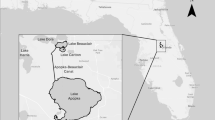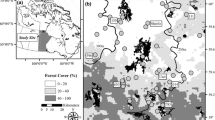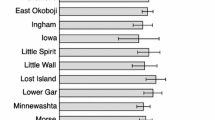Abstract
We investigated the ecological effects of terrestrial ecosystem change during the hemlock decline and recovery (4,800–3,500 BP) on lake communities (diatoms and chrysophytes). This study specifically assessed the role of catchment area and slope in determining the magnitude of lake eutrophication during the hemlock decline by analyzing sediment cores from five alkaline, holomictic lakes in southeastern Ontario, Canada. The study lakes were similar in most limnological aspects, but differed widely in the relative sizes of their catchments. Diatoms were used to quantitatively infer past lake-water total phosphorus (TP) concentrations.
All five lakes showed shifts in their algal communities during the hemlock decline, but most lakes exhibited only minor changes in trophic status. The magnitude of the limnological response appears to be related to catchment size and slope. Long Lake, Burridge Lake, and Gunter Lake possess the smallest catchments and exhibited the weakest responses to the hemlock decline. The catchment area of Flower Round Lake is considerably larger and steeper than these lakes, and was the only lake to show a marked eutrophication. Aulacoseira ambigua bloomed and diatom-inferred TP concentration increased by 14 µg 1−1.
Catchment slope appears to have influenced the type of material exported into the lakes. Lake basins draining catchments with gentle relief received proportionally greater amounts of organic matter, whereas steeper catchments supplied relatively greater proportions of mineral matter. Faster water flow associated with steeper catchment slope may have enhanced mineral erosion
Following the hemlock decline, nutrient supplies to most of the study lakes were reduced. The period of forest recovery was associated with an 11 µg 1−1 reduction in diatom-inferred lake-water TP concentration in Flower Round Lake, and algal populations decreased. Our results generally support the ecological theory of forest ecosystem development and secondary succession developed from long-term data collected at the Hubbard Brook Experimental Ecosystem.
Similar content being viewed by others
References
Allison, T.D., Moeller, R.E. & M.B. Davis, 1986. Pollen in laminated sediments provides evidence for a mid-Holocene forest pathogen outbreak. Ecology 64: 1101–1105.
Anderson, N.J., Rippey, B. & A.C. Stevenson, 1990. Change to a diatom assemblage in a eutrophic lake following point source nutrient redirection: a paleolimnological approach.Freshwat. Biol. 23: 205–217.
Anderson, T.W., 1987. Terrestrial environments and age of the Champlain Sea based on pollen stratigraphy of the Ottawa Valley-Lake Ontario region. In R.J. Fulton (ed.), Quaternary geology of the Ottawa region, Ontario and Québec. Geological Survey of Canada Paper 86–23: 31–47.
Baer, A.J., Poole, W.H. & B.V. Sanford, 1977. Rivière Gatineau, Québec-Ontario; Geological Survey of Canada, Map 1334A, 1:1,000,000 sheet, Geological Atlas of Canada.
Battarbee, R.W., 1973. A new method for the estimation of absolute microfossil numbers, with reference especially to diatoms. Limnol. Oceanogr. 18: 647–653.
Birks, H.H., Whiteside, M.C., Stark, D.M. & R.C. Bright, 1976. Recent paleolimnology of three lakes in Northwestern Minnesota. Quat. Res. 6: 249–272.
Birks, H.J.B., Line, J.M., Juggins, S., Stevenson, A.C. & C.J.F. ter Braak, 1990. Diatoms and pH reconstructions. Phil. Trans. R. Soc., Lond. B 327: 263–278.
Bormann, F.H. & G.E. Likens, 1979. Pattern and process in a forested ecosystem. Springer-Verlag, New York, 253 pp.
Bormann, F.H., Likens, G.E., Fisher, D.W. & R.S. Pierce, 1968. Nutrient loss accelerated by clearcutting of a forest ecosystem. Science 159: 882–884.
Bormann, F.H., Likens, G.E., Siccama, T.G., Pierce, R.S. & J.S. Eaton, 1974. The export of nutrients and recovery of stable conditions following deforestation at Hubbard Brook. Ecol. Monogr. 44: 255–277.
Boucherle, M.M., Smol, J.P., Oliver, T.C., Brown, S.R. & R. McNeely, 1986. Limnological consequences of the decline in hemlock 4800 years ago in three Southern Ontario lakes. Hydrobiologia 143: 217–225.
Bradbury, J.P., 1975. Diatom stratigraphy and human settlement in Minnesota. Geol. Soc. Amer. Special Paper 171: 1–74.
Brugam, R.B., 1978. Human disturbance and the historical development of Linsley Pond. Ecology 59: 19–36.
Camburn, K.E., Kingston, J.C. & D.F. Charles (eds.), 1986. PIRLA Diatom Iconograph. PIRLA unpublished report series 3, Dept. of Biology, Indiana University, Bloomington, U.S.A.
Chapman, L.J. & D.F. Putnam, 1984. The physiography of southern Ontario; Ontario Geological Survey, Special Volume 2. Government of Ontario, pp. 270.
Christie, C.E. 1993. Palcoecological reconstruction of lake trophic status: The effect of human activity on lake conditions in southeastern Ontario in the recent (ca. 200 years) past. Ph.D. Thesis, Queen's University, Kingston, Ontario, 211 pp.
Conley, D.J., 1988. Biogenic silica as an estimate of siliceous microfossil abundance in Great Lake sediments. Biogeochemistry 6: 161–179.
Crisman, T.L., 1977. North Pond, Massachusetts: post-glacial variations in lacustrine productivity as a reflection of changing watershed-lake interactions. Ph.D. thesis, Indiana University, 112 pp.
Davis, M.B., 1981. Outbreaks of forest pathogens in Quaternary history. Proc. IV int. Conf., Lucknow, (1976–77), 3: 216–227.
Dean, W.E., Jr., 1974. Determination of carbonate and organic matter in calcareous sediments and sedimentary rocks by loss on ignition: Comparison with other methods. J. Sediment. Petrol. 44: 242–248.
Dillon, P.J. & W.B. Kirchner, 1975. The effect of geology and land use on the export of phosphorus from watersheds. Wat. Res. 9: 135–148.
Engstrom, D.R. & H.E Wright, Jr., 1984. Chemical stratigraphy of lake sediments as a record of environmental change. In Haworth, E.Y. & J.W.G. Lund (eds), Lake sediments and environmental history. Leicester University Press, Leicester: 11–67.
Engstrom, D.R. & B.C.S. Hansen, 1985. Postglacial vegetational change and soil development in southeastern Labrador as inferred from pollen and chemical stratigraphy. Can. J. Bot. 63: 543–561.
Engstrom, D.R, Swain, E.B. & J.C. Kingston, 1985. A palaeolimnological record of human disturbance from Harvey's Lake, Vermont: geochemistry, pigments and diatoms. Freshwat. Biol. 15:261–288.
Faegri, K. & J. Iversen, 1975. Textbook of pollen analysis. Blackwell Scientific Publishers, Oxford, 295 pp.
Ford, M.S., 1990. A 10 000-yr history of natural ecosystem acidification. Ecol. Monogr. 60: 57–89.
Fowells, H.A., (ed.), 1965. Silvics of forest trees of the United States. United States Department of Agriculture Handbook 271. Washington, D.C., 762 pp.
Germain, H., 1981. Flore des diatomées: Diatomophycées. Société Nouvelle des Editions Boubée, Paris, 444 pp.
Gorham, E., Vitousek, P.M. & W.A. Reiners, 1979. The regulation of chemical budgets over the course of terrestrial succession. Ann. Rev. Ecol. Syst. 10: 53–84.
Håkansson, H. & E.F. Stoermer, 1984a. An investigation of the morphology of Stephanodiscus alpinus Hust. Bacillaria 7: 159–172.
Håkansson, H. & E.F. Stoermer, 1984b. Observations on the type material of Stephanodiscus hantzschii Grunow in Cleve & Grunow. Nova Hedwigia 39: 477–495.
Hall, R.I., 1993. Paleolimnological analysis of lake-watershed interactions and long term lake trophic status. PhD thesis, Biology Dept., Queen's University, Kingston, Ontario, Canada, 323 pp.
Hall, R.I. & J.P. Smol, 1992. A weighted-averaging regression and calibration model for inferring total phosphorus concentration from diatoms in British Columbia (Canada) lakes. Freshwat. Biol. 27: 417–434.
Hobbie, J.E. & G.E. Likens, 1973. Output of phosphorus, dissolved organic carbon, and fine particulate carbon from Hubbard Brook watersheds. Limnol. Oceanogr. 18: 734–742.
Hornbeck, J.W., 1975. Streamflow response to forest cutting and revegetation. Wat. Res. Bull. 11: 1257–1260.
Hosie, R.C., 1979. Native trees of Canada. Fitzhenry & Whiteside Ltd., Don Mills, Ontario, Canada, 380 pp.
Hustedt, F., 1930. Bacillariophyta (Diatomeae). Die Süss-wasserflora Mitteleuropas 10, 2nd edn. Gustav Fischer Verlag, Jena, 466 pp.
Jackson, S.T., 1990. Pollen source area and representation in small lakes of the northeastern United States. Rev. Paleobot. Palynol. 63: 53–76.
Kapp, R.O., 1969. How to know pollen and spores. Wm. C. Brown Co. Publishers. Dubuque, USA, 249 pp.
Kettles, I. M. & W.W. Shilts, 1987. Tills of the Ottawa region. In R.J. Fulton (ed.), Quaternary geology of the Ottawa region, Ontario and Quebec. Geological Survey of Canada Paper 86–23: 10–13.
Koppen, J.D., 1975. A morphological and taxonomic consideration of Tabellaria (Bacillariophyceae) from northcentral United States. J. Phycol. 11: 236–244.
Krammer, K. & H. Lange-Bertalot, 1986–1991. Süsswasser-flora von Mitteleuropa. 2(1–4). Gustav Fischer Verlag, Stuttgart, 4 Vols.
Likens, G.E., 1984. Beyond the shoreline: A watershed-ecosystem approach. Verh. Internat. Verein. Limnol. 22: 122.
Likens, G.E. & M.B. Davis, 1975. Post-glacial history of Mirror Lake and its watershed in New Hampshire, USA: an initial report. Verh. Internat. Verein. Limnol. 19: 982–993.
Likens, G.E., Bormann, F.H., Johnson, N.M., Fisher, D.W. & R.S. Pierce, 1970. Effects of forest cutting and herbicide treatment on nutrient budgets in the Hubbard Brook watershed-ecosystem. Ecol. Monogr. 40: 23–47.
Line, J.M. & H.J.B. Birks, 1990. WACALIB v. 2.1. A computer program to reconstruct environmental variables from fossil assemblages by weighted averaging. J. Paleolimnol. 3: 170–173.
Livingstone, D.A., 1955. A lightweight piston sampler for lake deposits. Ecology 36: 137–139.
Mackereth, F.J.H., 1966. Some chemical observations on post-glacial lake sediments. Phil. Trans. R. Soc. B. 250: 165–213.
Marks, P.L. & F.E. Bormann, 1972. Revegetation following forest cutting: mechanisms for return to steady-state nutrient cycling. Science 176: 914–915.
McAndrews, J.H. & J.E. King, 1976. Pollen of the North American Quaternary: The top twenty. Geoscience and Man 15: 41–49.
McAndrews, J.H., Berti, A.A. & A. Norris, 1973. Key to the Quaternary pollen and spores of the Great Lakes region. Royal Ontario Museum, Life Sciences Miscellaneous Publication, University of Toronto Press, Toronto, 64 pp.
Mott, R.J. & L.D. Farley-Gill, 1978. A late-Quaternary pollen profile from Woodstock, Ontario. Can. J. Earth Sci. 15: 1101–1111.
Patrick, R. & C. Reimer, 1966. The diatoms of the United States vol. 1. Academy of Natural Sciences, Philadelphia, Monograph 3: 1–668.
Patrick, R. & C. Reimer, 1975. The diatoms of the United States vol. 2 part 1. Academy of Natural Sciences, Philadelphia, Monograph 13: 1–213.
Prairie, Y.T. & J. Kalff, 1986. Effect of catchment size on phosphorus export. Wat. Res. Bull. 22: 465–470.
Prentice, I.C., 1980. Multidimensional scaling as a research tool in Quaternary palynology: A review of theory and methods. Rev. Paleobot. Palynol. 31: 71–104.
Sandgren, C.D., (ed.), 1988. Growth and reproductive strategies of freshwater phytoplankton. Cambridge University Press, 442 pp.
Schindler, D.W., 1971. A hypothesis to explain differences and similarities among lakes in the Experimental Lakes Area, northwest Ontario. J. Fish. Res. Bd. Can. 28: 295–301.
Smol, J.P., 1983. Paleophycology of a high arctic lake near Cape Herschel, Ellesmere Island. Can. J. Bot. 61: 2195–2204.
Smol, J.P., 1985. The ratio of diatom frustules to chrysophycean statospores: A useful paleoindicator. Hydrobiologia 123: 199–208.
Smol, J.P., 1992. Paleolimnology: an important tool for effective ecosystem management. J. Aquat. Ecosyst. Health 1: 49–58.
Smol, J.P. & M. M. Boucherle, 1985. Postglacial changes in algal and cladoceran assemblages in Little Round Lake, Ontario. Arch. Hydrobiol. 103: 25–49.
Stockner, J.G. & F.A.J. Armstrong, 1971. Periphyton of the Experimental Lakes Area, northwestern Ontario. J. Fish. Res. Bd. Can. 28: 215–229.
Stoermer, E.F., & J.J. Yang, 1968. A preliminary report of the fossil diatom flora from Lake Huron sediments. Proc. 11th Conf. Great Lakes Res., Int. Assoc. Gr. Lakes Res., Ann Arbour, Michigan: 253–267
Stoermer, E.F. & H. Håkansson, 1984. Stephanodiscus parvus: validation of an enigmatic and widely misconstrued taxon. Nova Hedwigia 39: 497–511.
Terasmae, J., 1981. Late-Wisconsin deglaciation and migration of spruce into southern Ontario, Canada. In R.C. Romans (ed.), Geobotany II. Plenum Publishing Corp., New York: 75–90.
Ter Braak, C.J.F., 1988. CANOCO — A FORTRAN program for canonical community ordination by (partial) (detrended) (canonical) correspondence analysis, principal components analysis, and redundancy analysis (version 2.1). Institute of Applied Computer Science, Statistical Department Wageningen, 6700 AC Wageningen, The Netherlands. Technical Report LWA-88–02, Wageningen, 95 pp.
Ter Braak, C.J.F., 1990. CANOCO — a FORTRAN program for CANonical Community Ordination. Microcomputer Power, Ithaca, NY, USA (including update notes).
Vallentyne, J.R., 1955. A modification of the Livingstone piston sampler for lake deposits. Ecology 36: 139–141.
Vitousek, P.M. & W.A. Reiners, 1975. Ecosystem succession and nutrient retention: a hypothesis. Bioscience 25: 376–381.
Whitehead, D.R., Rochester, H., Jr., Rissing, S.W., Douglas, C.B. & M.C. Sheehan, 1973. Late glacial and postglacial productivity changes in a New England pond. Science 181: 744–747.
Whitehead, D.R., Charles, D.F., Jackson, S.T., Smol, J.P. & D.R. Engstrom, 1989. The developmental history of Adirondack (N.Y.) lakes. J. Paleolimnol. 2: 185–206.
Author information
Authors and Affiliations
Rights and permissions
About this article
Cite this article
Hall, R.I., Smol, J.P. The influence of catchment size on lake trophic status during the hemlock decline and recovery (4800 to 3500 BP) in southern Ontario lakes. Hydrobiologia 269, 371–390 (1993). https://doi.org/10.1007/BF00028036
Issue Date:
DOI: https://doi.org/10.1007/BF00028036




